|
Battle of Cold Harbor Cemetery
Cold Harbor National Cemetery History
Battle of
Cold Harbor
Cold Harbor National Cemetery
| Cold Harbor National Cemetery |
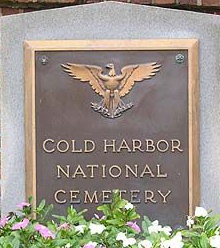
|
| Cold Harbor National Cemetery |
History
The Cold Harbor National Cemetery was established in 1866 and is
located on the site of the Battle of Cold Harbor and seven miles east of Mechanicsville. It was an historic clash between
General Robert E. Lee and General Ulysses S. Grant. It is one of six Civil War-era cemeteries
maintained by the Department of Veterans Affairs in the Richmond, Va., area. All these national cemeteries are historically
linked to the Union assault on the southern capital of Richmond: Seven Pines, Richmond, Glendale, City Point and Fort Harrison.
| Cold Harbor near Mechanicsville, VA. |
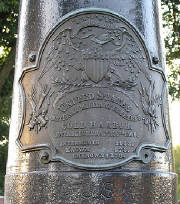
|
| Cold Harbor Cemetery Monument |
The 1.4-acre Cold Harbor Cemetery is preserved in a relatively rural context,
partly due to neighboring lands that are part of the discontiguous Richmond National Battlefield Park, which is managed by
the National Park Service. Across the road is the Garthright house, which served as a Union field hospital from June 3-12,
1864. The Battle of Cold Harbor (or Gaines Hill) occurred in June 1864, although cemetery burials were collected here from
a 22-mile area.
The layout is typical for small, older cemeteries, that of a nearly perfect
square with two 10'-wide bisecting paths and a central flagpole. Before, the permanent masonry structures were constructed,
the keeper resided in a white "wooden cottage" surrounded by a white picket fence and Osage orange hedge that kept animals
from disturbing the graves. Now, the cemetery features a standard masonry Second Empire lodge designed by Quartermaster General
Montgomery C. Meigs and a paneled brick enclosure wall. These were both constructed in 1871; by this date, just over $18,000
had been spent on the cemetery.
In the early 20th century, service structures including tool, well and oil
houses were built and rebuilt. Civil Works Administration laborers did much of this construction during the 1930s.
During the late 19th century, Cold Harbor was designated a third-class cemetery,
a rating based on size and activity (by comparison, Richmond National Cemetery was rated first-class). Acquisition of the
land by the U.S. government was formally completed in 1870 for $200, but the next year additional border acreage was purchased
for about $300. One of the first superintendents at the cemetery, Augustus Barry, is the only Medal of Honor recipient buried
here. Cold Harbor National Cemetery was listed on the National Register of Historic Places in 1995.
Monuments and Memorials
| Cold Harbor National Cemetery |
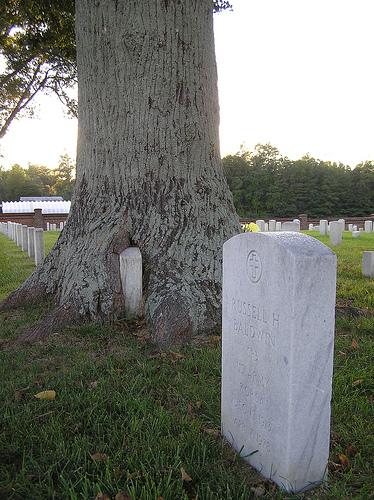
|
| 100 Year Old Tree Engulfing Headstone |
| Cold Harbor Civil War Battlefield |
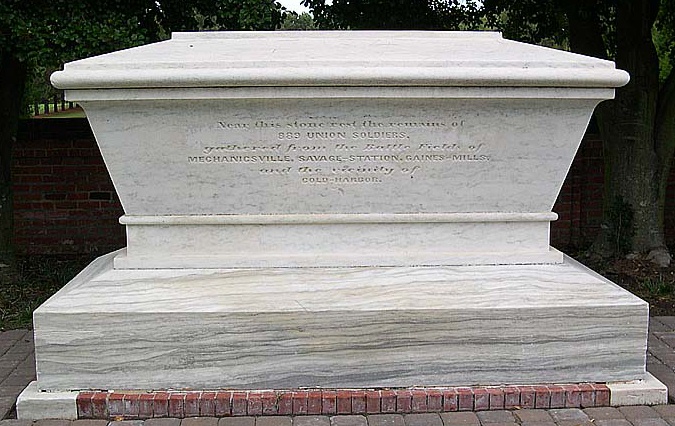
|
| Tomb of the Unknown Soldier |
(Above) The Tomb of the Unknown Soldier, built in 1877, is a 5-foot high
marble sarcophagus erected by the U.S. government at a cost of $2,151. It commemorates 889 unknown Union dead who were buried
in nearby trench graves located on the battlefields of Mechanicsville, Savage-Station, and Gaines Mills.
Cold Harbor Cemetery was established and opened in 1866, just two years
after the armies fought on this very ground. These trees, as seen to the right, are now growing to a size where
they're absorbing the surrounding tomb stones.
| Old Tree v. Cemetery |
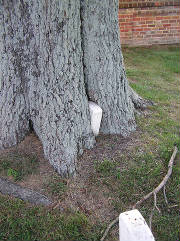
|
| Tree engulfs headstone |
| Close-up of Cemetery Tree |
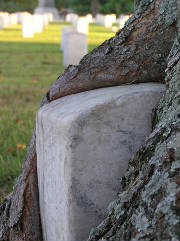
|
| The Cemetery Tree |
Cold Harbor Cemetery was established and opened in 1866, just two years after the
armies fought on this very ground. These trees, as seen to the right, are now growing to a size where
they're absorbing the surrounding tomb stones.
(Left) Planted more than one hundred years ago, this tree has devoured the
tombstone at Cold Harbor Battlefield.
The Pennsylvania Monument, built in 1909,
was erected by the Commonwealth of Pennsylvania to commemorate the losses of its regiments that fought at Cold Harbor
in 1864. The dedication ceremony, 45 years later, lasted six days and was attended by 690 of 937 surviving veterans of these
troops and commonwealth officials. A memorial commission was established in 1907, which set a limit of $5,000 for the cost
to build the memorial. Architect J. Henry Brown of Richmond designed the more than 30-foot tall granite shaft topped by a
soldier standing at parade rest.
The 8th New York Heavy Artillery Monument was erected in 1909 by the state
of New York to honor the 219 members of this regiment who died as a result of the Battle of Cold Harbor. The granite block
features a bronze tablet on which the names of the dead are listed.
One inverted cannon was installed by 1871 bearing a bronze plaque that identifies
the location of the cemetery and number of dead interred there.
Notable Persons
Source: Cold Harbor National Cemetery
Recommended Reading: Not War But Murder: Cold Harbor
1864. Library Journal: In June 3, 1864, the Union Second, Sixth, and Eighteenth Corps assaulted Confederate
breastworks at Cold Harbor outside Richmond, VA.
The resulting bloodbath -- total casualties in killed, wounded and missing -- amounted to U.S. Grant's worst defeat and "Bobby"
Lee's final great victory. In his latest book, native Virginian and Baltimore Sun correspondent
Furgurson (Chancellorsville, 1863) vividly retells the well-known story of how the friction between Grant and his insecure
direct subordinate, George Meade, poisoned the Army of the Potomac's whole chain of command.
Continued below…
By contrast,
he depicts Lee as a commander beset by poor health and impossible logistical problems who brilliantly deployed his meager
forces and soundly thrashed his overconfident adversary, thereby saving the rebel capital and extending an unwinnable war
by nearly a year. The book is rich in word pictures and engaging anecdotes. Furgurson considers the wounded that were left
to suffer with the dead between the lines while Lee and Grant quibble over protocols of recovery; the disastrous affect of
poor maps and impassable terrain on the Federal assault; and Grant's immediate need to bring Lincoln a battlefield victory
before the 1864 presidential election. Furgurson's contribution is his evocative retelling of a great American military tragedy.
Recommended Reading: Cold Harbor: Grant and
Lee, May 26-June 3, 1864, by Gordon C. Rhea (Hardcover). Description: In his gripping volume on the spring 1864 Overland campaign--which pitted Ulysses S. Grant
against Robert E. Lee for the first time in the Civil War--Gordon Rhea vividly re-creates the battles and maneuvers from the
North Anna stalemate through the Cold Harbor offensive. Rhea's tenacious research elicits
stunning new facts from the records of a phase oddly ignored or mythologized by historians. The Cold Harbor of these pages
differs sharply from the Cold Harbor of popular lore. We see Grant, in one of his most brilliant
moves, pull his army across the North Anna
River and steal a march on Lee. In response, Lee sets up a strong defensive
line along Totopotomoy Creek, and the battles spark across woods and fields northeast of Richmond.
Continued below…
Their back
to the Chickahominy River and on their last legs,
the rebel troops defiantly face an army-wide assault ordered by Grant that extends over three hellish days. Rhea gives a surprising
new interpretation of the famous battle that left seven thousand Union casualties and only fifteen hundred Confederate dead
or wounded. Here, Grant is not a callous butcher, and Lee does not wage a perfect fight. Every imaginable primary source has
been exhausted to unravel the strategies, mistakes, gambles, and problems with subordinates that preoccupied two exquisitely
matched minds. In COLD HARBOR,
Rhea separates fact from fiction in a charged, evocative narrative. He leaves readers under a moonless sky, Grant pondering
the eastward course of the James River fifteen miles south of the encamped armies. About
the Author: Gordon Rhea is the author of three previous books, a winner of the Fletcher Pratt Literary Award, a frequent lecturer
throughout the country on military history, and a practicing attorney.
Recommended Reading: Bloody Roads South: The Wilderness to Cold Harbor,
May-June 1864, by Noah Andre Trudeau. Description: "Nobody has brought together in one volume so many eyewitness accounts from both sides."-Civil War History
Winner of the Fletcher Pratt Award. In this authoritative chronicle of the great 1864 Overland Campaign in Virginia, Noah
Andre Trudeau vividly re-creates the brutal forty days that marked the beginning of the end of the Civil War. In riveting
detail Trudeau traces the carnage from the initial battles in Virginia's Wilderness to the
gruesome hand-to-hand combat at Spotsylvania's "Bloody Angle," to the ingenious trap laid by Lee at the North
Anna River, to the killing ground of Cold Harbor. Through fascinating eyewitness accounts, he relates the human stories behind this epic
saga. Continued below…
Common
soldiers struggle to find the words to describe the agony of their comrades, incredible tales of individual valor, their own
mortality. Also recounting their experiences are the women who nursed these soldiers and black troops who were getting their
first taste of battle. The raw vitality of battle sketches by Edwin Forbes and Alfred R. Waud complement the words of the
participants. PRAISE FOR THE BOOK: "Bloody Roads South is a powerful and eloquent narrative of the costliest, most violent
campaign of the Civil War. Grant vs. Lee in the Wilderness, at Spotsylvania, and at Cold Harbor has never been told better."-Stephen W. Sears, author of The Landscape Turned
Red. About the Author: Noah Andre Trudeau is an executive producer for cultural programs at National Public Radio in Washington, D.C. He is the author of
Out of the Storm: The End of the Civil War, April-June 1865 and The Last Citadel: Petersburg,
Virginia, June 1864-April 1865.
Recommended Reading: Trench Warfare under Grant and
Lee: Field Fortifications in the Overland Campaign (Civil War America)
(Hardcover) (The University of North
Carolina Press) (September 5, 2007). Description: In the study of field fortifications in the Civil War that began with Field Armies and Fortifications
in the Civil War, Hess turns to the 1864 Overland campaign to cover battles from the Wilderness to Cold
Harbor.
Drawing on
meticulous research in primary sources and careful examination of trench remnants at the Wilderness, Spotsylvania, North Anna,
Cold Harbor, and Bermuda Hundred, Hess describes Union and Confederate earthworks and how Grant and Lee used them in this new era of field
entrenchments.
Recommended Reading: Field Armies and Fortifications in the Civil War: The Eastern Campaigns,
1861-1864 (Civil War America)
(Hardcover). Description: The eastern campaigns of
the Civil War involved the widespread use of field fortifications, from Big Bethel and the Peninsula to Chancellorsville,
Gettysburg, Charleston, and
Mine Run. While many of these fortifications were meant to last only as long as the battle, Earl J. Hess argues that their
history is deeply significant. The Civil War saw more use of fieldworks than did any previous conflict in Western history.
Hess studies the use of fortifications by tracing the campaigns of the Army of the Potomac
and the Army of Northern Virginia from April 1861 to April 1864. Continued below...
He considers
the role of field fortifications in the defense of cities, river crossings, and railroads and in numerous battles. Blending
technical aspects of construction with operational history, Hess demonstrates the crucial role these earthworks played in
the success or failure of field armies. He also argues that the development of trench warfare in 1864 resulted from the shock
of battle and the continued presence of the enemy within striking distance, not simply from the use of the rifle-musket, as
historians have previously asserted. Based on fieldwork
at 300 battle sites and extensive research in official reports, letters, diaries, and archaeological studies, this book should
become an indispensable reference for Civil War historians.
Recommended Viewing: The Civil War - A Film by Ken Burns. Review: The
Civil War - A Film by Ken Burns is the most successful public-television miniseries in American history. The 11-hour Civil War didn't just captivate a nation,
reteaching to us our history in narrative terms; it actually also invented a new film language taken from its creator. When
people describe documentaries using the "Ken Burns approach," its style is understood: voice-over narrators reading letters
and documents dramatically and stating the writer's name at their conclusion, fresh live footage of places juxtaposed with
still images (photographs, paintings, maps, prints), anecdotal interviews, and romantic musical scores taken from the era
he depicts. Continued below...
The Civil War uses all of these devices to evoke atmosphere and resurrect an event that many knew
only from stale history books. While Burns is a historian, a researcher, and a documentarian, he's above all a gifted storyteller,
and it's his narrative powers that give this chronicle its beauty, overwhelming emotion, and devastating horror. Using the
words of old letters, eloquently read by a variety of celebrities, the stories of historians like Shelby Foote and rare, stained
photos, Burns allows us not only to relearn and finally understand our history, but also to feel and experience it. "Hailed
as a film masterpiece and landmark in historical storytelling." "[S]hould be a requirement for every
student."

|

